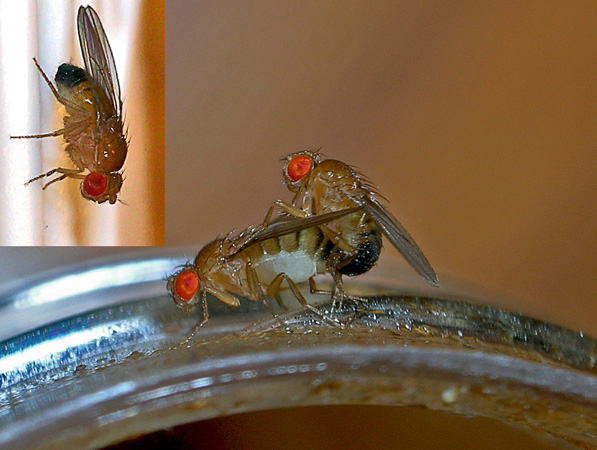Show Me The Science Month

How do new genes arise? One common way is through gene duplication - the creation of a second copy of a gene when the DNA replication or repair machinery goes awry, followed by the the evolution of a new function for one copy. How genes are accidentally duplicated is reasonably well understood, but once a gene is duplicated, but how does the new copy acquire a new function?
A pair of researchers in New York have looked at the role of a class of reproductive proteins in the mating behavior of different species of flies. One thing you can learn from this paper is that biologists will go to any length to learn about evolution - nobody watches fly sex for fun. Except for fly number three: (which was apparently put in by Photoshop):

But there are more lessons here. Mating behavior is in fact an excellent place to look for lessons about evolution, since reproduction is subject to strong evolutionary pressures. In the case of flies, male flies secrete proteins called accessory gland proteins (ACPs), which are essential for egg fertilization in flies. These proteins play a key role in the evolutionary race for reproductive success. For instance, in some species of flies where the females re-mate frequently, males have an an evolutionary incentive to produce ACPs that give their sperm a leg-up over that of other suitors. ACPs also play a variety of roles in promoting reproductive success, such as protecting reproductive tracts from microbial infections.
The bottom line is that ACPs tend to evolve quickly because of these evolutionary pressures.
The two researchers looked at ACP genes in the genomes of two fly species that have different mating behaviors. There were plenty of duplicate copies of ACP genes in these genomes, but is there evidence that these genes have acquired new functions?
To answer this question, the researchers looked at the rates of evolutionary change in these genes. Genes can evolve in three basic ways: 1) they can be resistant to change, because evolution is favoring the status quo (this is called negative selection); 2) they can evolve neutrally, meaning they steadily pick up random mutations which aren't weeded out by selection (this suggests that the gene may no longer be functional); and 3) they can change very rapidly, faster than the neutral rate, suggesting that evolution is favoring a new function (this is called positive selection). The idea here is that you can draw conclusions about how a gene is evolving based on how much that gene has changed between species.
We can apply this idea to gene duplication. After an accidental copying event, evolution may act to preserve both copies in a largely unchanged form, in which case both copies will exhibit few changes in DNA sequence - maybe each copy specializes in a slightly different function, which means that we'll see a few changes, but not many. Or, one copy may become completely useless, destroyed by mutation and thus evolving at the neutral rate. The final possibility is that one or both copies may be subject to positive selection, which means that evolution quickly favors randomly arising beneficial mutations. In this final case, either one or both copies will exhibit more DNA changes than you see at the neutral rate.
So what did the researchers find? Not surprisingly, it was a mixed bag. Some Acp genes are strongly constrained by evolution, meaning that they serve a critical function that tolerates no changes in the gene structure. But in many cases of duplicated genes, one copy evolved slowly (negative selection), while the other copy evolved very quickly (positive selection). This suggests that evolution is favoring the original function in one copy of the gene, and a new function in the other copy.
In other words, the authors found clear evidence for the evolution of new functions by gene duplication.





Comments